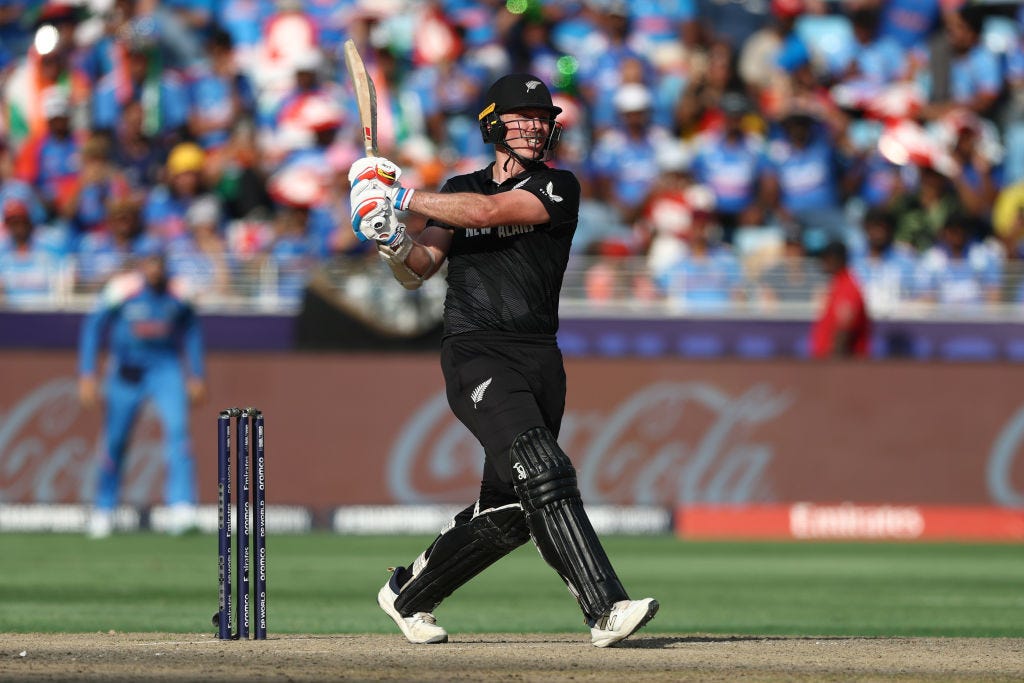A very quick appraisal of the weekend’s sport, which included a Champions Trophy final loss to India that managed to be both underwhelming and mildly admirable.
The reason for the brevity is an imminent minor medical procedure, which will see me sidelined for a few days. Please excuse the short absence and thanks for your patience in what has been a bit of a messy start to 2025.
Five things from a final that seldom soared.
1. To beat India in Dubai on a wicket more conducive to spin than the surfaces in Pakistan, New Zealand would need plenty of things to go their way — and early in the match they mostly did. Mitchell Santner won the toss and batted, and India dropped catches to give New Zealand a leg-up into the powerplay, which always looked like it was going to be the easiest time to bat. It wasn’t enough, however, because the one thing they most needed to go their way didn’t, and that occurred before a ball was bowled.
Matt Henry’s absence was a body blow. New Zealand lost not only the tournament’s top wicket-taker, but their most economical seamer and most-trusted death bowler. Obviously you can point to the fact that India were without Jasprit Bumrah, but they were without him all tournament and had their plans firmly in place. Gary Stead and Mitchell Santner had to adjust on the fly… and, in my eyes at least, went in a strange direction.
It’s easy to look at Nathan Smith’s figures (0-22 off two overs) and say he was an obvious weak link, but even as the news filtered out that Henry would miss the match, he would have been third of the three potential replacements behind Jacob Duffy and Mark Chapman. Nothing about Smith’s first forays into bowling in the international arena suggested that here was a guy to get through five or six damage-limitation overs in those conditions. Stead thrust an athlete with enormous potential and enormous inexperience in alongside the marginally less inexperienced Will O’Rourke and it backfired.
New Zealand’s three seamers combined for 14 overs, taking 1-102. This was not efficient use of manpower. You might look at India’s seamers, with Mohammed Shami and Hardik Pandya combining for a grim return of 1-104 off 12 overs, and say it all balanced out, but the difference being there was only two of them and Pandya is a genuine allrounder.
The principal reason the Black Caps’ seam-bowling struggles were more critical than those of India’s was that they didn’t have runs to play with. The runs per over might have been comparable, but India wasn’t defending a suboptimal 251.
2. Two things made New Zealand’s total a little tough to chew on: like the semifinal, they got a bright, table-setting opening partnership; and they finished only seven down (and the seventh wicket was a sacrificial run out).
They didn’t put it all on the line because they got bogged down big time in the middle overs. India’s spinners put Daryl Mitchell into a straitjacket he could not escape from.
The initial caution was understandable. Sensible even. Once Will Young had again been flummoxed by Varun Chakravarthy and Rachin Ravindra and Kane Williamson had fallen in quick succession to Kuldeep Yadav, a reset was needed. Over-optimistic projections of a 300-plus score needed to be scaled back. Two of New Zealand’s more experienced operators were at the crease, yet I find it hard to believe that 250 was the number Mitchell and Tom Latham settled on.
They dug New Zealand into a hole, advancing the score by 33 in the 11 painstaking overs they were together. More surprising was that apart from the odd flourish, Glenn Phillips did little to loosen the buckles on the straitjacket. He can hit good balls for six, but he and Mitchell put on 57 in 14-and-a-half overs.
Unless you’re in the middle, it’s impossible to tell exactly how difficult it is — and players like Ravi Jadeja and Axar Patel give you bad balls about twice a match — but if the boundaries are inaccessible, you have to move the scoreboard in other ways.
That middle-order axis of Mitchell, Latham and Phillips soaked up an unsustainable 16.5 overs of dot balls. It was like being taken back to 1980s World Series cricket — all that was missing was the beige uniforms and single-scoop bats.
The way Michael Bracewell came out and batted with no shortage of brio indicated that the middle order had been too conservative.
Keep reading with a 7-day free trial
Subscribe to The Bounce to keep reading this post and get 7 days of free access to the full post archives.




